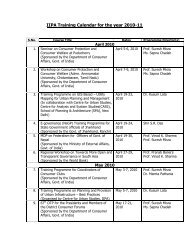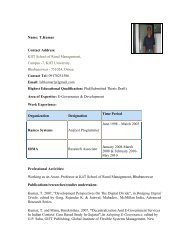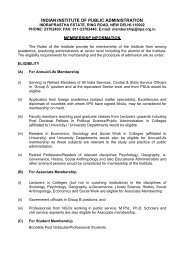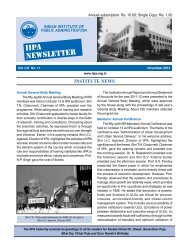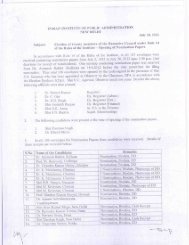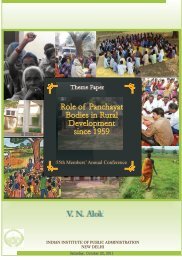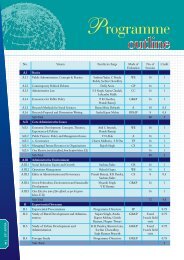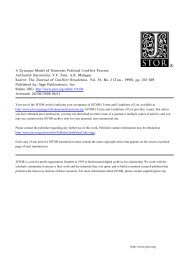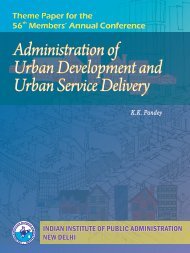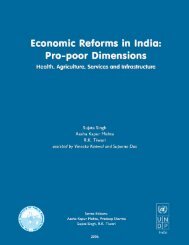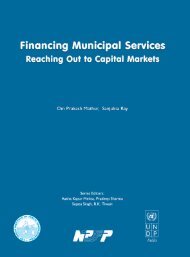India's Telecom Reform - Indian Institute of Public Administration
India's Telecom Reform - Indian Institute of Public Administration
India's Telecom Reform - Indian Institute of Public Administration
Create successful ePaper yourself
Turn your PDF publications into a flip-book with our unique Google optimized e-Paper software.
India’s <strong>Telecom</strong> <strong>Reform</strong>: A Chronological Account<br />
4<br />
Epilogue<br />
Between December 2003 and December 2005, several further<br />
developments have taken place in the field <strong>of</strong> telecom<br />
reforms, <strong>of</strong> which the important ones are dealt with below.<br />
Unified Access Service Licenses<br />
On 13 th January 2005 TRAI came out with recommendations<br />
on a unified licensing system in the country in line<br />
with the convergence <strong>of</strong> markets and technologies becoming<br />
a reality and forcing a realignment <strong>of</strong> the industry. According<br />
to the recommendations, a service provider may<br />
provide the service that was earlier provided by another<br />
type <strong>of</strong> service provider. A single service provider can<br />
now <strong>of</strong>fer telecommunication, cable and broadcasting services.<br />
The Unified Licensing Regime (ULR) is designed to<br />
encourage the free growth <strong>of</strong> new applications and services<br />
leveraging on the technological developments in Information<br />
and Communication Technology (ICT). Under<br />
ULR, operators would pay six percent <strong>of</strong> their adjusted<br />
gross revenue (contribution to USOF at five percent<br />
plus administrative cost <strong>of</strong> one percent) as license fee.<br />
The recommendations also include the proposal to allow<br />
niche operators to serve rural areas with a phone density<br />
<strong>of</strong> less than one percent. Niche operators would pay no<br />
entry fees. The recommendations envisage the migration<br />
<strong>of</strong> existing service providers to the ULR to be optional<br />
for current operators. However, after a period <strong>of</strong> five years<br />
it shall be mandatory for all telecom operators to migrate to<br />
the ULR. It is important to mention that these recommendations<br />
are pending with the government and yet to be accepted.<br />
Universal Service Obligation Fund<br />
The USO Fund was constituted in 2002 and an administrator<br />
was appointed. The Fund envisages auctions <strong>of</strong><br />
subsidies to operators who will serve rural areas. The<br />
guidelines issued by the USOF envisage subsidies to successful<br />
bidders for providing a variety <strong>of</strong> rural lines e.g.,<br />
village public phones, second phone lines, high speed<br />
internet centres as well as replacement <strong>of</strong> VPTs based on<br />
Mobile Access Rural Radios (MARR) technology. USOF<br />
subsidies have been awarded for providing a second VPT,<br />
termed rural community phone, in 46,253 villages <strong>of</strong><br />
population exceeding 2,000 and for private household<br />
phones in 1,685 SDCAs (roughly equivalent to a revenue<br />
taluka) that were identified by the administration as ‘unremunerative’<br />
in terms <strong>of</strong> telephone usage and revenues.<br />
However, TRAI has recently argued that the USOF approach,<br />
were it to be completely successful, would result<br />
in a rural tele-density <strong>of</strong> only four percent. A comprehensive<br />
rethink is required, especially to ensure that wireless technologies<br />
and infrastructure can be adequately supported, to<br />
replicate the huge success <strong>of</strong> mobiles in urban areas.<br />
Access Deficit Charge<br />
The ADC regime came into effect from 1 st May 2003 for<br />
compensating the Fixed Service Providers (FSPs), but predominantly<br />
BSNL, the incumbent and main provider <strong>of</strong><br />
fixed lines in India, for meeting the revenue deficit arising<br />
out <strong>of</strong> providing services below costs, i.e.,<br />
16




